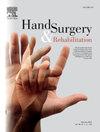前臂纵向不稳定(埃塞克斯-洛普雷斯蒂综合征)的病理生理学及对治疗的影响。
IF 1
4区 医学
Q4 ORTHOPEDICS
引用次数: 0
摘要
前臂纵向不稳或埃塞克斯-洛普雷斯蒂综合征与桡骨头骨折和连接两块骨头的结构(主要是骨间膜和邻近桡侧远端关节的三角纤维软骨复合体)破裂有关。这种情况起初常被忽视,如果桡骨头粉碎性骨折伴有肘关节脱位或不稳定,则应进行筛查。应在创伤后4周内及时治疗,以避免软组织回缩,并希望能使伤口愈合。这个时间间隔只是传闻,没有确凿证据,但与文献[1]中定期报告的观察结果相符。在急性期,治疗包括硬性(通常是单极)桡骨头置换、通过骨间的TightRope缝合扣保护骨间膜愈合、桡骨销钉和三角纤维软骨复合体缝合,然后固定6周。病情通常进展顺利。超过 4 周后,软组织无法愈合,则需要重建骨间膜。如果桡骨升高导致桡掌撞击,则必须进行尺骨缩短截骨术。这类病例的中期效果不那么确定。作为最后的手段,"单骨前臂 "是一种解决方案。本文章由计算机程序翻译,如有差异,请以英文原文为准。
Pathophysiology of longitudinal forearm instability (Essex-Lopresti syndrome) and implications for treatment
Longitudinal forearm instability, or Essex-Lopresti syndrome, associates radial head fracture and rupture of the structures uniting the 2 bones, mainly the interosseous membrane and triangular fibrocartilage complex adjacent to the distal radioulnar joint.
It is often overlooked at first, and should be screened for in case of comminuted radial head fracture without elbow dislocation or instability.
Treatment should be prompt, within 4 weeks of trauma, to avoid soft-tissue retraction and hopefully allow healing. This interval is anecdotal, without firm evidence, but matches observations regularly reported in the literature [1].
In the acute phase, treatment consists in rigid, usually unipolar, radial head replacement, protected healing of the interosseous membrane by a TightRope suture button between the bones, radioulnar pinning and triangular fibrocartilage complex suture, followed by 6 weeks’ immobilization. Progression is usually favorable.
Chronic forms, beyond 4 weeks, when soft-tissue healing is impossible, require interosseous membrane reconstruction. In case of radiocarpal impingement due to ascension of the radius, ulnar shortening osteotomy must be associated. Medium-term results in such cases are much less certain.
As a last resort, the “one-bone forearm” is a solution.
求助全文
通过发布文献求助,成功后即可免费获取论文全文。
去求助
来源期刊

Hand Surgery & Rehabilitation
Medicine-Surgery
CiteScore
1.70
自引率
27.30%
发文量
0
审稿时长
49 days
期刊介绍:
As the official publication of the French, Belgian and Swiss Societies for Surgery of the Hand, as well as of the French Society of Rehabilitation of the Hand & Upper Limb, ''Hand Surgery and Rehabilitation'' - formerly named "Chirurgie de la Main" - publishes original articles, literature reviews, technical notes, and clinical cases. It is indexed in the main international databases (including Medline). Initially a platform for French-speaking hand surgeons, the journal will now publish its articles in English to disseminate its author''s scientific findings more widely. The journal also includes a biannual supplement in French, the monograph of the French Society for Surgery of the Hand, where comprehensive reviews in the fields of hand, peripheral nerve and upper limb surgery are presented.
Organe officiel de la Société française de chirurgie de la main, de la Société française de Rééducation de la main (SFRM-GEMMSOR), de la Société suisse de chirurgie de la main et du Belgian Hand Group, indexée dans les grandes bases de données internationales (Medline, Embase, Pascal, Scopus), Hand Surgery and Rehabilitation - anciennement titrée Chirurgie de la main - publie des articles originaux, des revues de la littérature, des notes techniques, des cas clinique. Initialement plateforme d''expression francophone de la spécialité, la revue s''oriente désormais vers l''anglais pour devenir une référence scientifique et de formation de la spécialité en France et en Europe. Avec 6 publications en anglais par an, la revue comprend également un supplément biannuel, la monographie du GEM, où sont présentées en français, des mises au point complètes dans les domaines de la chirurgie de la main, des nerfs périphériques et du membre supérieur.
 求助内容:
求助内容: 应助结果提醒方式:
应助结果提醒方式:


